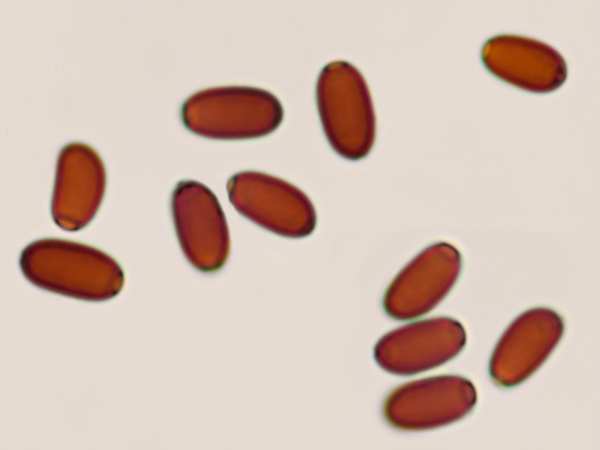Coprinopsis stercorea (Fr.) Redhead, Vilgalys & Moncalvo
Phylum: Basidiomycota - Class: Agaricomycetes - Order: Agaricales - Family: Psathyrellaceae
Distribution - Taxonomic History - Etymology - Identification - Toxicity - Reference Sources
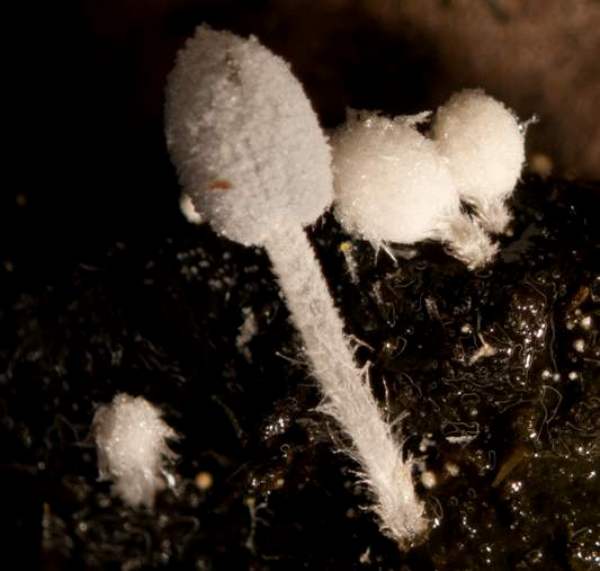
In the Fungal Records Database of Britain and Ireland (FRDBI) this is a very rarely recorded species; possibly due to the difficulty of identifying with confidence small white inkcaps growing on dung. (There are several similar species, and microscopic characters must be examined to separate them with certainty.)
Like all inkcaps, the fruitbodies of this mushroom are short lived, and so a patient observer could have an educational day watching a cap expand from an elongated egg to conical and then bell-like as the universal veil remnants fall away to reveal the underlying grey pileipellis. As with many other inkcaps, the gills of Coprinopsis stercorea are at least slightly deliquescent, a characteristic which aids spore dispersal particularly in wet weather.
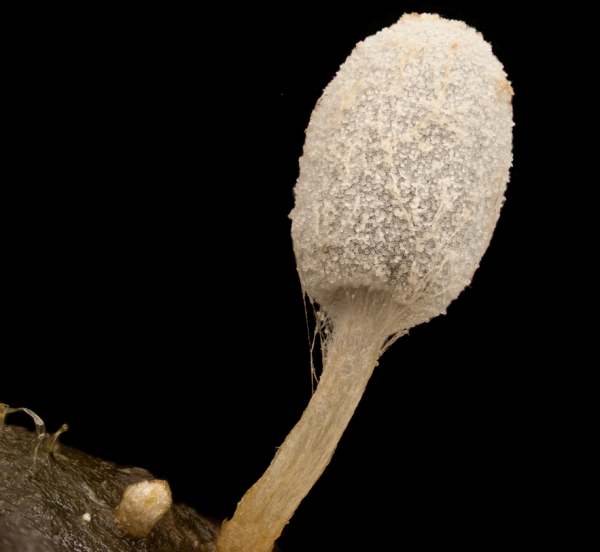
Distribution
Because the formal records for Coprinopsis stercorea in Britain are sparse, it seems inadvisable to try to infer from them a reliable indication of its distribution; however, this inkcap mushroom seems to be quite cosmopolitan in its worldwide distribution and is reported from Europe, Asia and North America.
Taxonomic history
This basionym of this little inkcap mushrooms dates from 1772, when it was described in Flora Carniolica by Italian mycologist Giovani Antonio Scopoli (1723 - 1788) under the name Agaricus stercorarius. Elias Magnus Fries sanctioned the specific epithet in his Hymenomycetes europae of 1874, when he transferred this species to the genus Coprinus.
This mushroom remained in the Coprinus genus until 2001 when, as a result of molecular (DNA) analysis by Redhead, Vilgalys & Moncalvo, the large Coprinus genus was shown to contain groups of fungi with only distant relationships to one another, and the earlier Coprinus group was dismantled with Coprinopsis stercorius being moved into the genus Coprinopsis within the family Psathyrellaceae. Coprinus comatus, the Shaggy Inkcap plus three other rare fungi are all that now remains of the formerly large Coprinus genus; however, many field guides and websites are yet to be updated in this respect.
Synonyms of Coprinopsis stercorea include Agaricus stercorarius Bull., Coprinus stercorarius (Bull.) Fr., and Coprinus stercoreus Fr.
Etymology
The generic name Coprinopsis indicates that mushrooms in this genus are similar in appearance to those in the genus Coprinus, which literally means 'living on dung' - that's true of quite a few of the inkcaps but not particularly apt for this and several other species. Somewhat tautologously, the specific epithet stercorea derived from the Latin word stercorarius, meaning 'of dung.
Common names change with time and location. In America the terms Inky Cap or Inky-cap are most commonly used, while in many older field guides published in Britain you are likely to see Ink Cap or Ink-cap rather than Inkcap.
Toxicity
Several of the more common Coprinopsis mushrooms - the Magpie Inkcap Coprinopsis picacea for example - are known to be poisonous, and as the edibility of Coprinopsis stercorea is unclear we recommend that this tiny inkcap should not be gathered for eating. In any case these are very rare mushrooms indeed and best left for others to see and enjoy.
Identification guide
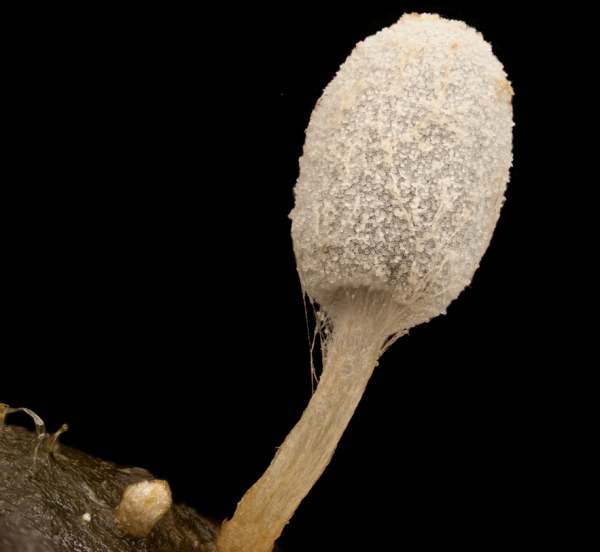 |
CapInitially ovoid to cylindrical, later expanding to convex and them campanulate or plane, often recurved and torn at the margin; 0.4--cm in diameter when fully expanded, becoming radially grooved; grey, covered in powdery mealy veil fragments, hairy towards the margin. GillsCrowded, free; white at first but turning black; weakly deliquescent. |
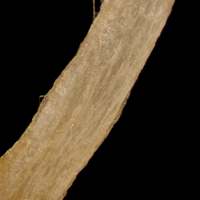 |
Stem2-5cm long and 0.5-1mm in diameter, white and hairy; sometimes slightly clavate at the base. |
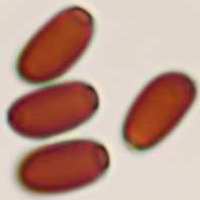 |
SporesEllipsoidal to cylindrical, smooth, 5.6-7.7 x 3.2-4.2µm; with a central germ pore; inamyloid. (Other Coprinopsis species have significantly larger and in particular broader spores.) Show larger imageSpore printBlack. |
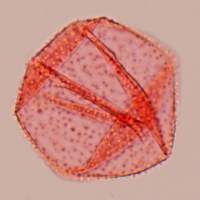 |
Veil elements consist of globose cells typically 80µm in diameter covered in warts connected by narrow diverticulate hyphae. (This is a key determining factor in the identification of this species.) |
Odour/taste |
Odour reported to be unpleasant (but given the growing substrate this is not easy to assess). It is inadvisable to taste fungi that grow on animal dung. |
Habitat & Ecological role |
Saprobic, singly or more often in small groups on various kinds of animal dung. |
Season |
Summer and autumn in Britain, based on very few records. |
Similar species |
There are several similar white inkcaps and separating them generally requires careful study of both macroscopic and microscopic characters as well as careful attention to the growing medium/substrate. |
Reference Sources
Coprinus stercoreus, Elias Magnus Fries, Epicrisis Systematis Mycologici: 251 (1838)
Orton, P.D. & Watling, R. (1979). British Fungus Flora: Agarics and Boleti. Vol 2. Coprinaceae: Coprinus. Royal Botanic Garden: Edinburgh.
Redhead SA, Vilgalys R, Moncalvo J-M, Johnson J, Hopple JS Jr.; Vilgalys, Rytas; Moncalvo, Jean-Marc; Johnson, Jacqui; Hopple, Jr. John S (2001). 'Coprinus Pers. and the disposition of Coprinus species sensu lato.'. Taxon (International Association for Plant Taxonomy (IAPT)) 50 (1): 203–41.
Breitenbach, J., Kränzlin, F., Fungi of Switzerland Agarics, 2nd part: Entolomataceae, Pluteaceae, Amanitaceae, Agaricaceae, Coprinaceae, Bolbitiaceae.
Dictionary of the Fungi; Paul M. Kirk, Paul F. Cannon, David W. Minter and J. A. Stalpers; CABI, 2008
Taxonomic history and synonym information on these pages is drawn from many sources but in particular from the British Mycological Society's GB Checklist of Fungi.
Acknowledgements
This page includes pictures kindly contributed by David Kelly.
Fascinated by Fungi. Back by popular demand, Pat O'Reilly's best-selling 450-page hardback book is available now. The latest second edition was republished with a sparkling new cover design in September 2022 by Coch-y-Bonddu Books. Full details and copies are available from the publisher's online bookshop...
